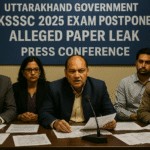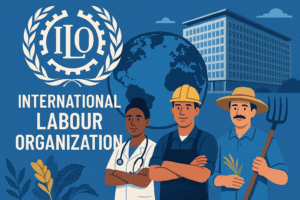
Monster Fire Vortex Spotted During Deer Creek Wildfire: Nature’s Fury Unleashed

A massive fire vortex, or fire tornado, formed during the Deer Creek wildfire, showcasing nature’s terrifying power. Here is everything you need to know about vortex phenomena and wildfire risks.
Table of Contents
Published: July 16, 2025 | Last Updated: July 16, 2025 | Author: Nueplanet
Overview: Fire Vortex Events and Their Meteorological Significance
Fire vortices represent a significant atmospheric phenomenon that occurs during large-scale wildfires under specific environmental conditions. The December 2024 Deer Creek wildfire in Oklahoma produced a notable example of this natural occurrence, drawing attention from meteorological researchers and emergency management professionals worldwide. These rotating columns of flames and hot gases form when intense heat from active wildfires interacts with wind patterns and terrain features, creating localized circulation patterns with measurable impacts on fire behavior and containment efforts.
Fire vortices differ fundamentally from conventional tornadoes in their formation mechanism and duration characteristics. While tornadoes develop from atmospheric instability in thunderstorm systems, fire vortices emerge directly from the thermal energy of active combustion. This distinction carries important implications for prediction methodologies, emergency response tactics, and firefighting strategies employed by agencies managing these events.
The scientific community recognizes fire vortices as part of the broader spectrum of extreme fire behavior, along with phenomena such as pyrocumulus cloud development and fire-induced wind patterns. Understanding these events requires examination of the physical mechanisms involved, historical precedents, climate factors influencing frequency, and practical implications for communities in fire-prone regions.
Understanding Fire Vortex Formation and Classification
Fundamental Mechanisms of Vortex Development
Fire vortices form through a series of interconnected physical processes that require specific atmospheric and fire behavior conditions to converge simultaneously. The formation mechanism depends on the interaction between thermal dynamics from active combustion and atmospheric wind shear patterns.
Intense heat generated by active wildfires creates strong vertical air currents. When fire temperatures exceed approximately 1,500°F (816°C), the superheated air becomes significantly less dense than surrounding cooler air, producing powerful updrafts. These updrafts can reach vertical velocities exceeding 100 miles per hour, effectively transporting hot gases, ash, and embers to considerable altitudes within the fire’s thermal column.
Horizontal wind patterns interact with these vertical currents in ways that produce rotational motion. When wind shear exists at different altitudes—meaning wind speed or direction changes with height—the vertical column begins to rotate. Terrain features such as hills, valleys, and ridges can enhance this wind shear effect, amplifying the rotational motion. The combination of strong buoyancy-driven updrafts with directional wind shear creates the distinctive rotating structure characteristic of fire vortices.
Environmental humidity and fuel moisture content influence whether vortex conditions develop. Fire vortices form most readily when relative humidity drops below 20 percent and vegetation moisture content falls below 5 percent. These extremely dry conditions allow fire intensity to reach the threshold necessary for sustained vortex development. Moisture in the air creates atmospheric stability that can suppress vortex formation, even when other favorable conditions exist.
Classification System for Fire Vortices
Fire vortices exhibit substantial variation in characteristics depending on the underlying atmospheric and fire conditions. Scientists classify these phenomena into distinct categories based on physical dimensions, duration, and intensity metrics.
Type 1: Ground-Level Fire Whirls
Ground-level fire whirls represent the most frequently observed category of fire vortices. These phenomena typically reach heights between 10 and 50 feet above the ground surface and maintain rotational motion for several minutes. Despite their smaller size compared to other vortex types, ground-level whirls can still produce damaging effects including localized structural damage and ember transport over short distances.
Ground-level fire whirls often form in response to intense surface heating and localized wind convergence patterns. They frequently occur at the periphery of active fires where thermal intensity remains substantial but atmospheric conditions remain relatively quiescent compared to the fire’s core regions. The rotational velocities in ground-level whirls typically range from 30 to 60 miles per hour, sufficient to cause minor structural damage and scatter burning debris.
Type 2: Intermediate-Scale Fire Tornadoes
Intermediate fire tornadoes represent a middle category between ground-level whirls and extreme vortex events. These phenomena typically extend 50 to 200 feet vertically and maintain organized rotation for 10 to 30 minutes. The rotational velocities in intermediate vortices typically range from 60 to 120 miles per hour, comparable to EF1 to EF2 tornado wind speeds.
Intermediate fire tornadoes develop when fire intensity combines with moderately strong wind shear at the mesoscale level. Unlike ground-level phenomena, intermediate vortices draw energy from substantial portions of the atmospheric column and can affect areas several hundred yards in diameter. These events can produce damage patterns resembling significant tornadoes and create hazardous conditions for firefighting operations and nearby communities.
Type 3: Extreme Fire Vortices
Extreme fire vortices represent the most intense manifestation of this phenomenon, with vertical extents exceeding 1,000 feet and rotational velocities potentially reaching 140 miles per hour or higher. These phenomena can maintain organized rotation for extended periods, sometimes persisting for several hours. The energy involved in extreme fire vortices rivals significant tornado events.
The Deer Creek wildfire in December 2024 produced an extreme fire vortex meeting or exceeding Type 3 classification criteria. This event exemplified how optimal combinations of fire intensity, atmospheric wind shear, low humidity, and terrain configuration can generate vortex phenomena of remarkable scale and intensity. Documentation of such events provides valuable data for improving understanding of the physical mechanisms involved.
The December 2024 Deer Creek Wildfire Event
Timeline and Incident Development
The Deer Creek wildfire emerged during a period of severe drought conditions affecting western Oklahoma. Environmental conditions preceding the fire included extended precipitation deficit, critically low fuel moisture levels, and atmospheric conditions favoring rapid fire spread.
December 15, 2024 – Fire Ignition and Initial Spread
The fire ignited in rural grassland areas of Beaver County, Oklahoma, during afternoon hours when atmospheric instability and wind speeds were both elevated. Initial reports indicated fire spread at a rate of approximately one mile per hour during the early stages of development. The combination of extremely dry conditions and gusty winds reaching approximately 45 miles per hour enabled rapid initial expansion. Relative humidity at time of ignition measured approximately 8 percent, representing conditions at the extreme end of the scale for fire danger.
December 16, 2024 – Rapid Expansion Phase
By the second day of the fire, burned acreage had exceeded 15,000 acres across the grassland terrain. Fire behavior remained aggressive throughout the day, with continued rapid spread toward the north and east. Weather conditions showed no moderation, with sustained winds continuing to drive the fire across drought-stressed vegetation. Emergency management agencies mobilized firefighting resources including personnel, aircraft, and ground support equipment in response to the expanding fire footprint.
December 17, 2024 – Fire Vortex Development
Late morning and early afternoon hours of December 17 produced the conditions necessary for fire vortex formation. At approximately 2:47 PM local time, multiple observers documented the appearance of a rotating column of flames and gases at the fire’s leading edge. Initial vortex formation appeared to involve rotational velocities and vertical extent rapidly increasing over a 10 to 15 minute period.
The fire vortex persisted for approximately two hours with periods of intensification and relative weakening. During peak intensity, the rotational column extended to estimated heights exceeding 1,000 feet, with observable rotational wind speeds estimated by observers and emergency responders to exceed 100 miles per hour. The phenomenon produced a distinctive appearance combining rotating flames at lower altitudes with a smoke column showing visible spiral structure.
Direct Impacts and Casualty Information
The fire vortex event produced measurable impacts on fire behavior, firefighting operations, and surrounding communities. Damage assessments documented destruction of 147 structures including residential properties and agricultural facilities. Property damage estimates exceeded $50 million based on preliminary assessments conducted by insurance adjusters and government agencies.
The vortex event created spot fires at distances up to five miles from the main fire perimeter through transport of burning embers. These outlying fires required emergency response from additional firefighting resources and complicated suppression operations significantly. The unpredictable nature of ember transport from vortex phenomena made traditional fire containment strategies partially ineffective.
Emergency responders reported zero fatalities directly attributable to the fire vortex phenomenon itself, though the broader wildfire event created significant hazards for both personnel and residents in affected areas. Evacuation of residents from threatened communities occurred without significant incident, though the rapidity of fire spread created logistical challenges for emergency management operations.
Eyewitness and Professional Observations
Local residents and emergency personnel documented observations of the fire vortex event through photographs, video recordings, and written accounts. Rancher Jake Morrison captured video footage from a distance of approximately two miles from the vortex that subsequently achieved widespread circulation through media outlets and social media platforms. Morrison described the visual appearance of the phenomenon as “a spinning column of flames rising to an enormous height with very rapid rotational motion.”
Emergency responder descriptions emphasized the distinctive sound characteristics of the phenomenon. First responder Sarah Chen, a meteorologist assigned to the emergency operations center, noted that “the vortex produced audible effects similar to high-intensity wind noise combined with roaring sounds from active combustion, audible at distances exceeding one mile away.”
Thermal imaging data recorded by aircraft-based thermal sensing systems documented temperatures within the vortex core reaching approximately 2,200°F (1,204°C). This temperature measurement significantly exceeded typical active fire temperatures, reflecting the concentration of thermal energy within the rotational circulation pattern. The extreme temperatures documented within the vortex contributed to structural damage patterns and vegetation destruction exceeding that typically produced by non-vortex wildfire events.
Physics and Meteorological Mechanisms Behind Fire Vortices
Heat-Induced Dynamics
The fundamental driving force behind fire vortex formation involves the thermal buoyancy generated by extreme heat from active combustion. Air at temperatures exceeding 1,500°F becomes substantially less dense than surrounding air at ambient temperatures, creating strong positive buoyancy forces that accelerate upward vertical motion.
The rate of vertical air acceleration within fire-heated columns can exceed that associated with typical thunderstorm updrafts. Research measurements from instrumented wildfires have documented vertical air velocities within smoke columns reaching 150 feet per second (approximately 102 miles per hour). These extreme vertical velocities create the strong updraft structure necessary for vortex formation.
The thermal profile of the atmosphere during fire vortex development typically shows extreme instability. The temperature decrease with altitude throughout the lower atmosphere exceeds the rate required by theoretical models of atmospheric convection. This environmental instability enables continued acceleration of rising air parcels to considerable altitudes without significant deceleration.
Wind Shear Interaction Mechanisms
Wind shear—the change in wind velocity with altitude—represents a critical factor enabling rotational motion development within fire-induced circulation. When wind speed increases with height while maintaining relatively constant direction, horizontal wind shear develops. This wind shear can be “tilted” into vertical orientation by the strong updrafts associated with fires, converting horizontal wind shear into vertical rotation.
The interaction between wind shear and buoyancy-driven updrafts follows physical principles well-established in atmospheric science literature. Strong updrafts can amplify small-scale rotation present in the ambient wind field, leading to rapid intensification of rotational circulation. The resulting circulation can reach rotational velocities comparable to or exceeding those observed in significant tornado formations.
Terrain features modify wind patterns in ways that enhance wind shear in specific locations. Valleys, ridges, and slopes create channeling effects that concentrate and intensify wind shear in particular areas. Fires developing in terrain-generated wind shear environments show higher probability of vortex formation compared to fires in flat terrain with similar atmospheric conditions.
Temperature Extremes and Physical Consequences
Temperatures within fire vortex cores represent among the highest naturally-occurring temperatures in Earth’s near-surface environment outside of volcanic activity. Documented measurements from thermal sensing systems indicate temperatures approaching or exceeding 2,200°F (1,204°C) within vortex cores.
These extreme temperatures produce physical consequences including melting of materials typically considered heat-resistant. Aluminum melts at 1,220°F (660°C), well below documented fire vortex core temperatures. Steel loses substantial structural strength at temperatures above 1,100°F (593°C). These material limitations constrain structural survival in proximity to active vortex formations.
Thermal radiation from fire vortex cores transmits extreme heat energy to surrounding areas. Objects at distances up to 500 yards from vortex centers can receive sufficient thermal radiation to cause ignition. This radiative heating capability enables creation of spot fires far removed from the primary vortex structure and contributes substantially to fire spread in vortex-producing wildfire events.
Historical Fire Vortex Events
The Carr Fire Tornado (California, July 2018)
The Carr Fire in Northern California produced an extreme fire vortex event on July 26, 2018, that achieved recognized tornado classification based on damage patterns. This fire vortex persisted for over two hours and demonstrated characteristics consistent with EF3 tornado intensity classification.
Meteorological measurements and damage assessments documented rotational wind speeds within the vortex exceeding 143 miles per hour. The damage path created by this vortex extended approximately 1,000 yards in width and affected an area where the fire vortex produced structural damage indistinguishable from tornado damage patterns. The vortex generated a pyrocumulonimbus cloud extending to approximately 39,000 feet altitude, creating a visible atmospheric column extending multiple miles above the ground.
The Carr Fire tornado caused two confirmed fatalities and destroyed more than 1,000 structures. Insurance assessments and government damage surveys documented losses exceeding $200 million attributed directly to the fire vortex event itself, with total fire losses exceeding $1.6 billion. This event remains among the most significant documented fire vortex events in recent North American history.
The Canberra Firestorm (Australia, January 2003)
Australia’s devastating Canberra firestorm in January 2003 produced multiple fire vortex events during an extraordinary fire behavior episode affecting the national capital region. The extreme fire event generated wind speeds within vortex structures exceeding 120 miles per hour and produced multiple simultaneous vortex formations.
These fire vortex phenomena contributed to damage of over 500 residential structures and destruction of numerous public buildings. Firebrand transport distances documented during the Canberra event extended up to eight miles from primary fire structures, demonstrating the vortex phenomenon’s capability to transport burning embers across substantial distances. The event resulted in approximately 500 million dollars in damages and claimed four lives.
Long-term environmental impacts from the Canberra firestorm included persistent changes to local weather patterns and atmospheric circulation characteristics extending months beyond the fire event. Research studies examining the atmospheric effects of the firestorm documented anomalies in regional weather patterns persisting for extended periods.
The Peshtigo Fire Complex (Wisconsin, October 1871)
The Peshtigo fire event in Wisconsin on October 8, 1871 occurred simultaneously with the better-known Great Chicago Fire and produced fire behavior including multiple fire vortex formations. This fire event, occurring well before modern instrumental meteorological measurements, generated written accounts documenting vortex phenomena.
Contemporary accounts describe fire vortices of remarkable scale and intensity that leveled entire townships and created unique geological formations through extreme heating. Eyewitness descriptions indicate formation of multiple simultaneous vortex events during the peak phase of fire development. The historical record suggests this event may have involved one of the largest aggregations of fire vortex activity ever documented.
Geological evidence preserved in soil formations and rock analysis indicates that heating temperatures during the Peshtigo fire event reached levels comparable to documented modern fire vortex events. The spatial distribution of extreme heating visible in the historical landscape suggests that multiple vortex phenomena of substantial scale contributed to the observed damage patterns.
Climate Change and Extreme Fire Behavior
Temperature Trend Analysis
Global average surface temperatures have increased approximately 1.1°C (2°F) above pre-industrial baseline values as of 2024. Within fire-prone regions, temperature increases during fire season months show even greater magnitude, with some areas documenting increases up to 3°C (5.4°F) during the months when large wildfires occur most frequently.
Temperature increases translate directly into lower fuel moisture values at equivalent relative humidity levels. Warmer air masses require greater absolute humidity to achieve specific relative humidity percentages. Since vegetation moisture content correlates more closely with absolute humidity than with relative humidity, warming produces drier vegetation at similar relative humidity conditions.
The cumulative effect of decadal temperature increases has extended the fire season in many regions and increased the number of days when fuel moisture values fall within ranges conducive to fire vortex formation. Historical records show seasonal fire danger metrics increasing measurably over multi-decade periods in fire-prone regions worldwide.
Drought Pattern Evolution
Climate modeling studies project significant changes in precipitation patterns and drought frequency as global temperatures continue to increase. Current projections indicate that drought episodes previously occurring with 20-year recurrence intervals may become 5 to 7 year events in many regions by mid-century.
Extended drought periods create cumulative effects on vegetation moisture and fuel accumulation. Multi-year droughts allow fuel moisture to decline to extreme levels throughout the landscape and permit dead fuel accumulation from tree mortality and insect outbreaks to reach high levels. These combined factors substantially increase fire intensity potential and the probability of extreme fire behavior including vortex formation.
Water resource implications of changing precipitation patterns will create competing demands for limited water supplies. Wildfire suppression operations require substantial water quantities, potentially conflicting with agricultural and municipal water needs during periods when both demands peak simultaneously.
Atmospheric Circulation Pattern Changes
Climate scientists document changes in large-scale atmospheric circulation patterns associated with changing global temperature differentials between equatorial and polar regions. These circulation pattern changes alter wind patterns at both regional and continental scales.
Some modeling studies suggest that changes in jet stream behavior and regional wind patterns may increase wind shear in fire-prone regions during peak fire season months. Enhanced wind shear would increase the probability of fire vortex formation when fires of sufficient intensity develop.
The precise magnitude and direction of future circulation pattern changes remain subjects of active research. High-resolution climate models produce variable projections for some regions, creating uncertainty about future wind pattern changes in specific fire-prone areas.
Frequency and Intensity Projections
Scientific projections indicate increasing frequency of conditions favorable for fire vortex formation through the remainder of the 21st century. Current modeling suggests a 40 percent increase in the number of days annually meeting fire vortex formation criteria by the 2030-2040 decade.
If these projections prove accurate, the geographic regions experiencing fire vortex phenomena would expand into areas that have not historically experienced such phenomena. Communities currently without experience managing fire vortex events would require development of new emergency response capabilities and public awareness programs.
Projection uncertainties remain substantial due to complex interactions between temperature changes, precipitation pattern shifts, vegetation dynamics, and land management practices. Nevertheless, the general direction of change suggests increasing fire vortex risk across a broad geographic range.
Emergency Response and Firefighting Challenges
Tactical Response Modifications
Fire vortex phenomena create specialized challenges for firefighting operations that differ from conventional wildfire suppression tactics. The unpredictable behavior and rapid movement of fire vortex phenomena complicate traditional containment strategies.
Firebreak establishment requires substantially greater distances when vortex phenomena present risk compared to conventional fire scenarios. Fire vortex phenomena can generate spot fires through ember transport at distances exceeding five miles from the primary fire perimeter. Traditional firebreaks effective against non-vortex fires prove inadequate for protecting communities threatened by vortex phenomena.
Aircraft deployment for aerial suppression requires specialized protocols when fire vortices develop. Rotorcraft operations near fire vortex phenomena carry increased risks due to wind shear and thermal turbulence within and around vortex structures. Fixed-wing aircraft dropping retardant require adjusted targeting and timing to account for vortex movement and unpredictable fire behavior.
The Deer Creek event involved deployment of over 200 firefighting personnel from multiple agencies including Oklahoma Department of Agriculture firefighters, National Guard emergency units, hotshot crews from surrounding states, and specialized wildfire suppression aircraft. Coordination requirements between agencies and tactical decision-making challenges demonstrate the complexity of managing fires producing vortex phenomena.
Personnel Safety Protocols
Fire vortex phenomena present extreme hazards to firefighting personnel that require specialized safety protocols. The combination of extreme heat radiation and unpredictable vortex movement creates danger zones extending well beyond distances typically associated with conventional fire suppression hazards.
Heat exposure represents the primary personnel hazard associated with fire vortex phenomena. Thermal radiation from vortex cores can cause severe burns at distances up to 500 yards. Personnel exposure to such radiation must be prevented through maintenance of adequate separation distances and tactical positioning that prioritizes personnel safety over fire suppression effectiveness.
Wind hazards associated with vortex phenomena can create dangerous conditions for personnel and equipment. Vortex-generated wind gusts exceeding 100 miles per hour can overturn vehicles, displace portable equipment, and create falling object hazards from flying debris. Personnel protocols require mandatory evacuation and sheltering procedures when vortex phenomena develop.
Specialized equipment including enhanced personal protective equipment, thermal monitoring systems, and communication devices enable improved personnel safety during fire vortex events. Training programs for personnel likely to encounter vortex phenomena emphasize recognition, evacuation procedures, and decision-making processes appropriate for these extreme scenarios.
Technology and Prediction Systems
Doppler Radar Detection Methods
Doppler weather radar systems can identify rotational signatures within smoke columns and fire-generated circulation patterns. These radar signatures often appear 20 to 45 minutes before visual fire vortex formation becomes apparent to ground observers.
The rotational circulation producing radar-detected velocity couplets develops within the smoke column before the vortex intensifies sufficiently to produce visible flame rotation at lower altitudes. This temporal lag between radar detection and visible vortex formation provides valuable lead time for emergency responders to implement protective actions.
Modern integrated radar networks covering fire-prone regions enable cooperative detection efforts where multiple radar facilities observe the same atmospheric features from different angles. This multi-platform observation capability improves detection confidence and measurement precision.
Satellite-Based Thermal Monitoring
High-resolution thermal satellites can detect extreme heat signatures characteristic of fire vortices at spatial resolutions down to approximately 100 meters. The distinctive thermal signature of an organized fire vortex differs from typical active fire thermal signatures in ways that enable automated detection algorithms to identify vortex phenomena.
Thermal satellite observations provide advantages including lack of dependence on ground-based infrastructure, continuous monitoring across large geographic areas, and detection capabilities extending through daylight and darkness conditions. Disadvantages include limited temporal resolution compared to ground-based systems and constraints on measurement precision.
Integration of satellite thermal data with Doppler radar observations and conventional weather measurements creates a multi-platform observation system providing complementary information about vortex phenomena. This integrated approach improves both detection probability and measurement accuracy compared to single-platform systems.
Atmospheric Profiling Systems
Weather balloon and ground-based LIDAR (Light Detection and Ranging) systems provide detailed vertical atmospheric profiles revealing temperature, humidity, and wind structure. These measurements enable meteorologists to assess the atmospheric conditions conducive to fire vortex formation.
LIDAR systems can detect smoke layers and atmospheric layers with sharp density discontinuities that influence vortex development. The vertical wind profile measured by LIDAR systems reveals wind shear at various altitude ranges, enabling assessment of atmospheric conditions supporting vortex formation.
Strategic deployment of profiling systems in fire-prone regions during periods of elevated fire danger enables real-time monitoring of atmospheric conditions. Observations from these systems feed into forecast models and decision support systems used by fire managers and emergency responders.
Predictive Modeling Developments
Advanced computational fluid dynamics models incorporate detailed fire behavior physics, atmospheric dynamics, and topographic influences to simulate fire vortex formation and evolution. These models can predict vortex probability based on fire intensity, atmospheric conditions, and terrain characteristics.
Machine learning approaches applied to historical fire and weather data identify patterns preceding vortex formation. These pattern recognition systems can provide probabilistic forecasts of vortex occurrence based on real-time observations of fire and atmospheric conditions.
Current prediction models achieve approximately 70 percent accuracy in identifying high-risk conditions for fire vortex formation. Emerging AI-based systems incorporating enhanced data integration and algorithmic sophistication aim to improve accuracy to 85 percent or higher within the next several years.
Community Preparedness and Safety
Evacuation Planning and Execution
Communities in fire-prone regions require evacuation plans specifically accounting for fire vortex phenomena. These plans must establish trigger points for evacuation decisions accounting for fire vortex development as an additional hazard beyond conventional wildfire spread.
Evacuation route planning must incorporate understanding of fire vortex behavior including the potential for spot fire development at distances five miles or greater from primary fire areas. Traditional evacuation zones presumed safe based on distance from active fire may require expansion when vortex phenomena create risk at extended distances.
Communication systems ensuring rapid dissemination of evacuation orders and emergency information require hardening to prevent service disruptions from fire vortex phenomena. Redundant communication pathways and backup systems enable continued emergency information transmission even if primary systems experience disruption.
Individual Preparedness Measures
Property protection measures for communities in fire vortex-susceptible regions should include enhanced construction standards for fire-resistant roofing materials and building exteriors. Buildings with fire-resistant features show substantially improved survival rates when exposed to extreme heat radiation from fire vortex phenomena.
Defensible space creation around residential properties requires extending clear zones to distances of 100 feet or greater, substantially exceeding recommendations for conventional wildfire scenarios. Extended defensible space provides separation from both direct fire exposure and thermal radiation from nearby burning vegetation.
Emergency supply preparations appropriate for fire vortex scenarios require 72 hours of provisions including water, food, medications, and essential documents. Rapid evacuation decisions necessitated by vortex phenomena leave limited time for supply gathering, requiring advance preparation of emergency kits.
Community Education and Awareness
Public awareness programs concerning fire vortex phenomena remain limited in many fire-prone regions. Educational initiatives introducing fire vortex concepts to community members, particularly those in high-risk areas, improve public understanding and support for emergency preparedness measures.
School-based programs introducing fire vortex science to students create awareness among future community leaders and decision-makers. Integration of fire vortex phenomena into science curricula provides appropriate educational content while raising public consciousness regarding these phenomena.
Professional development programs for emergency responders, public officials, and community leaders ensure that decision-making personnel understand fire vortex phenomena and implications for emergency management activities.
Frequently Asked Questions
What distinguishes fire vortices from conventional tornadoes?
Fire vortices and conventional tornadoes represent distinct phenomena with different formation mechanisms. Conventional tornadoes develop from atmospheric instability within thunderstorm systems, with rotation originating from wind shear within the storm structure.
Fire vortices form directly from thermal buoyancy generated by extreme heat from active wildfires, requiring interaction between vertical updrafts and ambient wind shear. While both phenomena involve rotating air columns, fire vortices are driven by combustion energy rather than thunderstorm dynamics.
The temperature regimes also differ substantially, with fire vortex core temperatures exceeding 2,200°F compared to ambient air temperatures surrounding conventional tornadoes. Duration characteristics also differ, with fire vortices potentially persisting for hours while conventional tornadoes typically last minutes.
What geographic regions show highest probability of fire vortex occurrence?
Fire vortex phenomena occur globally wherever conditions combine intense wildfires with appropriate atmospheric characteristics. Regions with Mediterranean climate patterns including Southern Europe, Australia, and portions of California show relatively high frequency of fire vortex events. Areas with grassland vegetation in semi-arid climates including portions of the Great Plains and Australian interior also experience frequent fire vortex development.
Boreal forest regions in Canada and Russia show lower frequency but potentially higher intensity vortex events due to large fuel loads. Tropical savanna regions of Africa and Australia experience fire vortex phenomena during the dry season. The common factor across all these regions involves the development of extreme drought conditions during specific seasons when both fire intensity and atmospheric wind shear potentially reach high values.
How frequently do fire vortex phenomena occur, and are frequencies changing?
Fire vortex occurrence frequency varies significantly by region and atmospheric conditions. Ground-level fire whirls occur numerous times annually across fire-prone regions worldwide, with dozens documented in North America alone during active fire seasons. Intermediate-scale fire tornadoes occur less frequently, with approximately 2-3 documented globally per year during active fire seasons.
Extreme fire vortices comparable to Type 3 phenomena occur rarely, with documented events numbering less than one per year globally on average. Documentation challenges and variable reporting practices complicate precise frequency assessment. Scientific studies examining fire trends over recent decades document increasing frequency of documented fire vortex events, though improvements in detection systems and increased public attention may contribute to increased documentation rates.
Climate modeling studies project that favorable conditions for fire vortex formation could increase 40 percent by 2040.
Can current meteorological systems predict fire vortex formation with useful accuracy?
Current prediction systems identify high-risk conditions for fire vortex formation with approximately 70 percent accuracy. Doppler radar systems can detect rotational signatures within smoke columns 20-45 minutes prior to visible vortex formation, providing advance warning time.
However, precise prediction of vortex location, timing, and intensity remains challenging due to complex interactions between multiple variables. Meteorologists can identify days when atmospheric conditions favor vortex formation if fires of sufficient intensity develop, but cannot predict exact location of future vortex formation.
Emerging AI-based prediction systems incorporating enhanced data integration aim to improve accuracy to 85 percent or higher in coming years. Real-time fire behavior monitoring combined with atmospheric observations enables better prediction than atmospheric observations alone.
What immediate actions should individuals take if encountering fire vortex phenomena?
Individuals encountering fire vortex phenomena should immediately move away from the vortex using the safest available route. Driving directly toward, parallel to, or through fire vortex phenomena represents extremely dangerous behavior. If escape by vehicle becomes impossible, individuals should abandon the vehicle and seek shelter in substantial buildings or depressions in terrain.
Covering oneself with wet clothing offers some thermal protection from radiative heat exposure. Direct exposure to fire vortex phenomena carries extreme hazard including thermal burns at distances exceeding 500 yards from vortex centers.
Respecting evacuation orders and maintaining safe distance from fire-affected areas represents the safest response. Individuals should not attempt to observe fire vortex phenomena at close range or retrieve property from areas threatened by vortex activity.
What research initiatives are advancing fire vortex understanding?
Multiple research programs are advancing understanding of fire vortex phenomena through complementary approaches. Computational fluid dynamics modeling simulates fire vortex formation and evolution, enabling investigation of the physical mechanisms involved. Laboratory-controlled fire experiments enable researchers to study vortex physics in environments where variables can be carefully controlled and measured.
Field research programs deploy specialized instruments near active wildfires to collect measurements of vortex phenomena. Satellite monitoring systems provide unprecedented spatial coverage of fire events and atmospheric conditions.
Machine learning approaches applied to historical fire and atmospheric data identify patterns preceding vortex formation. Collaborative international research programs facilitate data sharing and research collaboration across geographic regions. NASA has initiated development of space-based fire weather monitoring systems designed to provide global fire observation capabilities by 2027.
How will future climate changes influence fire vortex frequency and characteristics?
Climate scientists project that increasing global temperatures and changing precipitation patterns will increase conditions favorable for fire vortex formation. Temperature increases reduce vegetation moisture content at equivalent relative humidity levels, enabling more frequent attainment of extreme fire conditions. Projected changes in atmospheric circulation patterns may enhance wind shear in some fire-prone regions.
Extended drought periods would allow fuel moisture to decline to extreme levels and permit fuel accumulation to reach high levels. Combined effects would increase probability of intense fires developing under atmospheric conditions supporting vortex formation.
Geographic expansion of fire vortex-prone regions would expose areas currently without fire vortex experience to this phenomenon. Frequency projections suggest 40 percent increase in favorable conditions by 2040, though uncertainty remains regarding actual vortex occurrence frequency change. Preparedness initiatives should anticipate fire vortex risk expansion into currently lower-risk regions.
What structural and preparedness measures provide best protection against fire vortex phenomena?
Building construction incorporating fire-resistant materials substantially improves structural survival probability. Fire-resistant roofing materials, exterior cladding, and window protection reduce ignition probability from radiative heat exposure and flying embers. Defensible space extending 100 feet or greater from structures reduces exposure to thermal radiation and provides separation from burning vegetation.
Underground sheltering provides maximum protection from thermal radiation and extreme winds. Emergency supply kits with 72 hours of provisions enable sheltering in place if evacuation becomes impossible. Family communication plans established prior to fire events enable location of family members if evacuation separates household members.
Multiple evacuation route planning ensures continued escape routes if primary routes become blocked by fire spread. Awareness of local fire vortex risk and appropriate response actions enables rapid decision-making during crisis situations.
Implications and Future Considerations
Emergency Management Adaptations
Agencies responsible for emergency management in fire-prone regions are adapting procedures and resource allocation based on understanding of fire vortex phenomena. Detection and prediction system investments prioritize capabilities enabling early identification of vortex-favorable conditions. Personnel training programs now incorporate fire vortex recognition and appropriate response procedures. Equipment specifications for emergency response vehicles increasingly include thermal shielding and enhanced heat resistance. Interagency coordination procedures emphasize real-time communication about fire vortex development and risk assessment updates.
Research and Development Priorities
National and international research programs are prioritizing advancement of fire vortex prediction systems and understanding of underlying mechanisms. Funding allocations increasingly direct resources toward fire weather research and extreme fire behavior phenomena. Academic institutions are expanding graduate programs in fire meteorology and extreme weather phenomena. International collaboration initiatives facilitate data sharing and research coordination across geographic regions and national boundaries.
Policy and Regulatory Considerations
Regulatory frameworks are beginning to incorporate fire vortex phenomena into building codes and land use planning requirements for fire-prone regions. Building code revisions increasingly specify fire-resistant materials and design features appropriate for extreme fire exposure scenarios. Land use planning increasingly incorporates fire vortex risk assessment alongside conventional wildfire hazard analysis. Emergency management regulations now commonly require specific planning and preparedness measures for fire vortex phenomena in high-risk regions.
Summary and Key Takeaways
Fire vortex phenomena represent a significant manifestation of extreme wildfire behavior with documented impacts on firefighting operations, emergency management, and community safety. The December 2024 Deer Creek wildfire event in Oklahoma produced a Type 3 extreme fire vortex demonstrating the scale and intensity that these phenomena can achieve.
Formation of fire vortices requires convergence of intense wildfire activity with specific atmospheric conditions including low humidity, wind shear, and atmospheric instability. The interacting physical mechanisms producing these phenomena follow well-established principles of fluid dynamics and thermodynamics, yet the complexity of real-world fire and atmospheric systems creates ongoing uncertainty regarding specific triggering mechanisms.
Historical fire vortex events including the 2018 Carr Fire, 2003 Canberra firestorm, and 1871 Peshtigo fire demonstrate that these phenomena have occurred across varying geographic regions and time periods. Documentation of these historical events combined with contemporary observations provides valuable data for improving understanding of fire vortex behavior.
Climate change influences on fire and weather patterns project increased frequency of conditions favorable for fire vortex formation through the remainder of the 21st century. Expanding geographic distribution of fire vortex risk requires development of new emergency response capabilities in currently unaffected regions.
Technological advances in detection, prediction, and monitoring systems provide improving capabilities for identifying and tracking fire vortex development. Integration of satellite observations, Doppler radar data, atmospheric profiling, and computational modeling creates multifaceted monitoring approaches superior to single-platform systems. Investment in advanced warning systems represents an important component of community preparedness strategies in fire-prone regions.
Emergency management agencies, firefighting organizations, and community leaders must prioritize preparedness initiatives accounting for fire vortex phenomena. Education of the public about fire vortex characteristics and appropriate response actions increases community resilience. Development and maintenance of emergency response capabilities appropriate for fire vortex scenarios ensures that communities can respond effectively when these phenomena occur.
Individual preparedness measures including property hardening, defensible space creation, emergency supply development, and evacuation planning provide protection at the household level. These measures prove most effective when undertaken before fire season in recognition that emergency situations create limited time for protective action implementation.
Operational Considerations for Emergency Managers
Resource Allocation and Deployment Strategies
Emergency managers in fire-prone regions must develop resource allocation strategies accounting for fire vortex phenomena as distinct hazards requiring specific response capabilities. Personnel training, equipment procurement, and communication system development should incorporate fire vortex-specific requirements.
Aircraft deployment during fire events requires coordination between aircraft operators, fire management personnel, and meteorologists to ensure safe operations when vortex phenomena develop. Timing of aerial suppression efforts and retardant deployment requires adjustment based on real-time fire vortex monitoring. Integration of aircraft operations with ground-based suppression tactics requires enhanced coordination compared to non-vortex fire scenarios.
Equipment positioning and personnel staging areas must maintain adequate distances from fire areas accounting for spot fire risk from vortex-transported embers. Traditional staging area locations appropriate for conventional wildfire suppression may prove inadequate when vortex phenomena create hazards at extended distances.
Interagency Communication Systems
Effective emergency response to fire vortex phenomena depends on real-time communication between meteorological services, fire management agencies, emergency management organizations, and public safety personnel. Establishment of communication protocols ensuring rapid information dissemination about fire vortex development represents a critical preparedness function.
Integration of meteorological monitoring capabilities with fire management decision-making processes requires development of liaison positions and communication interfaces between these typically separate organizational structures. Real-time meteorological briefings to fire management personnel enable incorporation of weather information into tactical decisions.
Public communication about fire vortex phenomena and evacuation orders requires emphasis on accuracy and timeliness. Communication system redundancy ensures continued message delivery even if primary systems experience disruption from fire effects.
Training and Professional Development
Firefighting personnel working in regions where fire vortex phenomena occur should receive specialized training addressing vortex recognition, behavior patterns, and appropriate response tactics. Training programs should include classroom instruction on fire vortex physics and decision-making frameworks appropriate for vortex scenarios.
Hands-on training exercises using fire simulators and modeling exercises enable personnel to develop decision-making skills in realistic scenarios. Participation in multi-agency exercises including fire vortex scenarios improves coordination between organizations responding to fire emergencies.
Professional development programs for emergency managers and public officials ensure that decision-making personnel understand fire vortex phenomena and implications for emergency planning and response. Educational initiatives reaching elected officials and community leaders improve policy support for fire vortex preparedness investments.
Public Communication and Risk Awareness
Messaging Strategies for Fire Vortex Hazards
Effective public communication about fire vortex phenomena requires balancing between providing appropriate hazard information and avoiding excessive alarm. Messages should convey factual information about fire vortex characteristics, occurrence probability, and appropriate protective actions.
Risk communication research indicates that public understanding and acceptance of preparedness recommendations improves when messages emphasize personal agency and actionable protective measures. Communication emphasizing that individuals can reduce risk through specific preparedness actions proves more effective than communication emphasizing hazard severity alone.
Use of visual materials including photographs and video of documented fire vortex events enhances public understanding of hazard characteristics. Visual materials combined with scientific explanation of fire vortex formation and behavior create comprehensive communication packages promoting public understanding.
Community Engagement Initiatives
Community presentations and educational forums provide opportunities for fire management personnel, meteorologists, and emergency managers to communicate directly with residents about fire vortex hazards and preparedness strategies. These forums also provide opportunities for residents to ask questions and discuss specific concerns about their particular communities and properties.
Integration of fire vortex information into school curricula reaches younger audiences and improves long-term public awareness. Science classes provide appropriate venues for introducing fire vortex physics and phenomena. Social studies and civics classes can address emergency management and community preparedness dimensions.
Community preparedness fairs and open houses at emergency management facilities provide opportunities for residents to view emergency response equipment and discuss preparedness measures with emergency personnel. These informal education settings often prove effective in reaching diverse community demographics.
Media Relations and Public Information
Media representatives responsible for coverage of wildfire events benefit from advance training and background information about fire vortex phenomena. Media kits including explanations of fire vortex formation, historical examples, and safety information enable more accurate media coverage.
Designation of official spokespersons for fire vortex events ensures message consistency and accuracy. Spokespersons should receive training addressing commonly asked questions about fire vortex phenomena and appropriate response messages for various public concerns.
Social media monitoring and engagement enables emergency management organizations to address public concerns and provide rapid corrections of misinformation. Real-time social media communication during fire vortex events provides emergency information to populations that may not monitor traditional media sources.
International Cooperation and Knowledge Sharing
Cross-National Research Collaboration
Fire vortex phenomena occur globally, making international research collaboration valuable for advancing understanding across geographic regions and climatic contexts. Shared databases documenting documented fire vortex events enable statistical analysis across large numbers of cases.
Joint research projects between institutions in different countries facilitate standardization of measurement methodologies and enable direct comparison of fire vortex characteristics across regions. International conferences and workshops dedicated to fire vortex research and extreme fire behavior phenomena provide forums for researchers to present findings and collaborate on ongoing studies.
Access to research infrastructure including specialized instruments, computational facilities, and field study locations can be facilitated through international cooperative agreements. Smaller countries or regions lacking specialized research facilities benefit from collaborative arrangements providing access to advanced research capabilities.
Information Sharing Networks
Establishment of international networks facilitating rapid sharing of information about active fire vortex events improves understanding of global occurrences. Centralized databases enabling access to photographs, video footage, and measurement data from documented fire vortex events support research efforts and emergency management planning.
Training and professional development exchanges enable fire management and emergency response personnel to learn from colleagues in other countries with greater experience managing fire vortex phenomena. Exchange programs provide opportunities for direct observation of fire management operations in different geographic and institutional contexts.
Standardization of Measurement and Classification
Development of standardized methodologies for measuring fire vortex characteristics including intensity, duration, and damage extent enables comparison of documented events across time and geography. International agreements on measurement standards and classification schemes facilitate data integration from diverse sources.
Standardized terminology and classification frameworks enable clear communication among researchers and emergency management personnel from different countries. Adoption of consistent terminology reduces ambiguity in technical communications about fire vortex phenomena.
Long-Term Monitoring and Research Needs
Extended Observational Programs
Long-term monitoring of fire vortex phenomena across multiple decades and geographic regions will provide data enabling improved understanding of frequency trends and characteristics. Systematic documentation of fire vortex events including photography, video, measurement data, and impact assessment creates historical records supporting statistical analysis.
Integration of fire vortex observations with climate and land use data enables investigation of relationships between environmental variables and fire vortex occurrence. Multi-decade datasets revealing changes in fire vortex characteristics over time provide evidence regarding environmental and climate influences on these phenomena.
Establishment of networks of field monitoring stations in fire-prone regions enables collection of atmospheric and fire behavior measurements during active wildfires. Real-time data from these monitoring networks supports research investigations and enables operational meteorological services to improve fire weather forecasting.
Targeted Research Questions
Investigation of the relationship between specific atmospheric conditions and fire vortex occurrence probability remains an active research area. Identification of atmospheric “fingerprints” reliably predicting vortex formation would substantially improve operational forecasting capabilities.
Research examining why some fires of apparently similar intensity and atmospheric conditions produce vortices while others do not would improve understanding of the physical mechanisms involved. Detailed case study investigations combining measurements and modeling can address these questions.
Study of the efficiency with which fire vortices transport embers and the mechanisms determining transport distance and distribution patterns would improve understanding of spot fire risk associated with vortex phenomena. This research has direct applications to emergency planning and community preparedness.
Investigation of the effectiveness of various suppression techniques specifically for vortex phenomena would provide operational guidance to fire managers. Controlled experiments and operational case studies could establish which tactics prove most effective under various fire vortex scenarios.
Conclusion: Advancing Understanding and Preparedness
The December 2024 Deer Creek wildfire and its associated fire vortex event exemplified both the power and complexity of extreme wildfire phenomena. This event contributed substantially to scientific understanding of fire vortex mechanisms and operational experience in managing these extreme events.
Ongoing advancement of fire vortex understanding requires sustained investment in research, monitoring, and operational capabilities. As climate patterns continue to evolve and atmospheric conditions shift, fire vortex phenomena will likely increase in frequency in many regions. Communities in fire-prone areas must adapt their emergency management and preparedness approaches to account for this evolving hazard.
Technology continues to provide improved capabilities for detecting, monitoring, and predicting fire vortex formation. Integration of satellite observations, radar-based detection systems, atmospheric profiling instruments, and advanced computational modeling creates monitoring systems substantially more capable than single-platform approaches.
Preparedness at individual, community, and regional levels represents the most effective approach to reducing the risks posed by fire vortex phenomena. Property hardening, defensible space creation, emergency supply development, evacuation planning, and public awareness initiatives all contribute to community resilience.
Emergency management professionals, firefighting personnel, meteorologists, and researchers must continue collaborating on understanding and preparing for fire vortex phenomena. International cooperation in research and information sharing enhances global capacity to address this hazard.
The scientific community continues advancing fire vortex research through computational modeling, laboratory experiments, field studies, and analysis of documented events. Emerging technologies and analytical methods promise improved understanding of these phenomena in coming years.
As communities navigate increasing wildfire risk in a changing climate, understanding fire vortex phenomena and developing appropriate preparedness measures represents an important component of comprehensive wildfire risk management strategies. The lessons learned from the Deer Creek event and other documented fire vortex phenomena will inform emergency management and preparedness efforts for years to come.
Helpful Resources
Latest Posts
- National RailOne App: Indian Railways’ One-Stop Solution for Travellers
- HDB Financial Services IPO Allotment GMP: All You Need to Know
- TNPSC Admit Card 2025 Released: Everything You Need to Know
- Jharkhand Polytechnic Result 2025 Declared: Check Your Scores, Merit List, and Admission Process
- 7th July Public Holiday India: Is Muharram 2025 a National Holiday?






















Post Comment